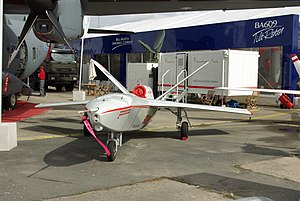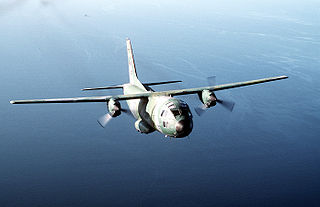
The Aeritalia G.222 is a medium-sized STOL military transport aircraft. It was developed to meet a NATO specification, but Italy was initially the only NATO member to adopt the type. The United States purchased a small number of G.222s, designating them the C-27A Spartan.

The Dassault nEUROn is an experimental unmanned combat aerial vehicle (UCAV) being developed with international cooperation, led by the French company Dassault Aviation. Countries involved in this project include France, Greece, Italy, Spain, Sweden and Switzerland. The design goal is to create a stealthy, autonomous UAV that can function in medium-to-high threat combat zones. Comparable projects include the British BAE Systems Taranis, German/Spanish EADS Barracuda, Turkish Baykar Bayraktar Kızılelma, American Boeing X-45 and Northrop Grumman X-47B, the Indian DRDO AURA, and the Russian Mikoyan Skat and Sukhoi Okhotnik.

The Piaggio PD.808 was an Italian business jet built by Piaggio. It was designed as a joint venture between Piaggio and Douglas Aircraft Company of Long Beach, California, United States.

The BAI Aerosystems (BAIA) BQM-147 Dragon unmanned aerial vehicle is a tactical battlefield UAV operated by the US Marine Corps.
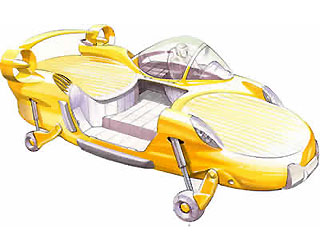
The Urban Aeronautics X-Hawk is a proposed flying car designed by Rafi Yoeli in Yavne, Israel, being built by Metro Skyways Ltd., a subsidiary of Yoeli's privately held company, Urban Aeronautics. The firm claims to have flown the car to a height of 90 cm (3 ft), and that greater heights are possible. The X-Hawk and its smaller unmanned version, the Tactical Robotics Cormorant, would be used in search and rescue operations where a helicopter would be useless, or at least very dangerous, such as evacuating people from the upper stories of burning buildings, or delivering and extracting police and soldiers while very close to structures, narrow streets, and confined spaces, with a projected size similar to that of a large van.
The Piaggio P.32 was an Italian medium bomber of the late 1930s, produced by Piaggio, and designed by Giovanni Pegna. It was a modern design for its time, but was a failure due to lack of powerplants commensurate with its high wing loading.

The General Dynamics X-62 VISTA is an experimental aircraft, derived from the F-16D Fighting Falcon, which was modified as a joint venture between General Dynamics and Calspan for use by the United States Air Force (USAF). Originally designated NF-16D, the aircraft was redesignated X-62A on 14 June 2021 as part of an upgrade to a Skyborg, with System for Autonomous Control of Simulation (SACS).
The Alenia ITV is a technology demonstrator aircraft developed in Italy in the early 21st century. In the spring of 2003, Alenia Aeronautica of Italy unveiled a non-flying ground-test prototype of a half-scale unmanned combat aerial vehicle demonstrator, known as an "Integration Technology Vehicle (ITV)", with a flight prototype to follow. The ITV has a high-mounted wing with a sweep of 35 degrees; a vee tail; a Microturbo TRI60-5 turbojet, with 4.4 kN thrust, mounted on the back behind the wing; retractable tricycle landing gear; and metal construction.
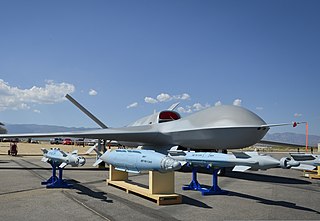
The General Atomics MQ-20 Avenger is a developmental unmanned combat aerial vehicle built by General Atomics Aeronautical Systems for the U.S. military.

The AeroVironment Wasp III Small Unmanned Aircraft System is a miniature UAV developed for United States Air Force special operations to provide a small, light-weight vehicle to provide beyond-line-of-sight situation awareness. The aircraft is equipped with two on-board cameras to provide real-time intelligence to its operators. It is also equipped with GPS and an Inertial Navigation System enabling it to operate autonomously from takeoff to recovery. It was designed by AeroVironment Inc., and was first added to the Air Force inventory in 2007. There are two Wasp variants: the traditional version that lands on land, and a version that lands into the sea or fresh water. The Air Force accepted the Wasp AE in late May 2012, and the U.S. Marine Corps revealed in January 2013 that they had ordered the Wasp AE. The Wasp AE is designated as the RQ-12A.

The Italian Alenia Aeronautica Sky-Y is a self-financed MALE Unmanned air vehicle for demonstration and research purpose; on 30 October 2007 it set a new European endurance record in the over 1000 kg category with a spotless eight-hour flight. Since 2016 manufacturer became Leonardo-Finmeccanica as Alenia Aermaccchi merged into the new Finmeccanica.
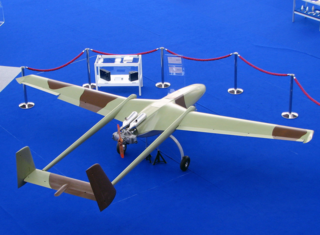
The PEGAZ 011 is a medium-range tactical UAV for day and night attack, reconnaissance and surveillance missions, target acquisition and designation developed by Military Technical Institute in Serbia and produced by Utva Aviation Industry, subsidiary of Yugoimport SDPR. Its flight autonomy is over 12 hours, and it sends data from the height of 6,000 m. Powered by a two-cylinder boxer type of engine with 32 kW (43 HP), it reaches the maximum flight speed of 200 km/h. The PEGAZ has a maximum weight of 240 kg, including about 50 kg of reconnaissance/surveillance equipment. It is 5.4 m long with a wingspan of 6.34 m. It takes off automatically from improvised runways and performs tasks along pre-programmed flight. There are two hardpoints for optional air-to-surface missiles for attack variant.
The Imperial Eagle is an Indian light-weight mini-unmanned aerial vehicle (UAV) developed by the Aeronautical Development Establishment, National Aerospace Laboratories and supported by private vendors. Its primary users will be the National Security Guard and the military services.

The Kohl Mythos is a German observation ultralight aircraft, designed by Stefan Kohl, and produced by S.A.I. Aeronautica, later by German Aircraft GmbH and most recently by Officine Meccaniche Mingarelli (OMM). When it was available the aircraft is supplied as a kit for amateur construction or complete and ready-to-fly.

The Fly-Fan Shark is a Slovak light aircraft designed by Frantisek Sustek and initially developed by Fly-Fan of Trenčín. Development continues under the new owner of the design, AENEA Services. The design was introduced at the AERO Friedrichshafen show in 2007 as a mock up and in 2011 as a flying aircraft. The aircraft first flew on 29 June 2011 and is intended to be supplied as a complete ready-to-fly-aircraft.

TAI Gözcü is a radio-controlled short-range tactical drone. Designed, developed and built by Turkish Aerospace Industries (TAI), the unmanned aerial vehicle (UAV) is in use by the Turkish Armed Forces for intelligence, surveillance, target acquisition and reconnaissance purposes. Gözcü is the Turkish word for observer.
Guangzhou EHang Intelligent Technology Co. Ltd is a company based in Guangzhou, China that develops and manufactures autonomous aerial vehicles (AAVs) and passenger AAVs which have entered service in China for aerial cinematography, photography, emergency response, and survey missions.

The NASA X-57 Maxwell is an experimental aircraft being developed by NASA, intended to demonstrate technology to reduce fuel use, emissions, and noise. The first flight of the X-57 is scheduled to take place in 2023.

Tactical Airborne Platform for Aerial Surveillance-Beyond Horizon-201 or TAPAS BH-201 is a Medium Altitude Long Endurance (MALE) unmanned aerial vehicle (UAV) being developed in India by Aeronautical Development Establishment (ADE) on the lines of General Atomics MQ-1 Predator. The first flight of the UAV took place in November 2016.

The Eviation Alice is an electric aircraft designed to accommodate nine passengers and two crew members. Currently under development, its construction incorporates 95% composite material, is powered by two electric motors, and has a T-tail. The prototype first flew on 27 September 2022.
